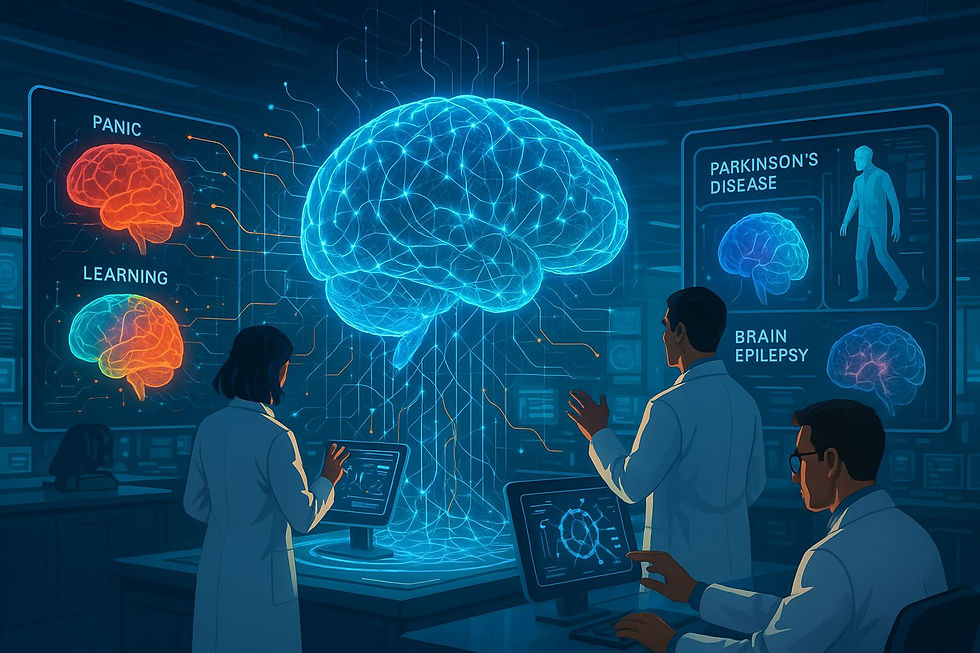The Power of Computational Neuroscience: A Deep Look
- AV
- Jul 10
- 3 min read
Computational neuroscience works closely with our understanding of how the brain functions. It is laying the groundwork to improve our progress in AI, treatment of medical disorders, and beyond. This dynamic field integrates biology, mathematics, and computer science by unlocking the full functionality of the brain. With the power of data analysis and precise simulations, scientists are unlocking the mysteries of neural systems, paving the way for remarkable discoveries.
The brain has cells called neurons that transmit information as signals. The junction at which the neurons transmit information is called a synapse. At its core, computational neuroscience seeks to understand how neurons and synapses contribute to the formation of human emotions and behaviors. They build models to analyze neural activity, which captures signals even related to decision-making processes.

Those actions that are otherwise impossible to assess can be tested using computational neuroscience by initiating simulations. We can understand how the neural framework works in situations such as panic, learning, and other human states. On the medical science aspect, disorders like Parkinson's disease and brain epilepsy can be effectively studied through neural networks with practical simulations. Computational neuroscientists are making significant inroads in understanding brain function by refining theories and supporting the best research.
Let us now examine the three critical approaches in computational neuroscience.
Simulating single neurons: In this approach, models simulate how an individual neuron reacts when receiving information. Here, studies on the action potentials of these single neurons are conducted, along with an examination of how individual neurons communicate and fire information.
Network modeling: This approach takes a broader perspective, examining how a cluster of neurons communicates with one another. The different models used here range from tiny circuits for sensory processes to large models of entire brain regions.
Theory Analysis: In this approach, data and neural networks are carefully analyzed using mathematical tools for in-depth examination. This analysis helps us understand and answer specific questions, such as how the brain processes emotions and learns, or how vast networks remain stable by performing concurrent operations.
Computational neuroscience employs various models and tools to address multiple questions. The Hodgkin-Huxley model is the foundational theory explaining the generation of action potentials, or electrical signals, by neurons. This model enables the simulation of complex biological processes.
On a larger scale, neural network models, such as spiking neural networks or artificial neural networks (ANNs), simulate the communication between groups of neurons. These models help researchers understand various aspects, including memory formation and sensory processing. Upon simulating the large area of the visual cortex, it was found that neurons detect edges in our vision.

Deep learning serves as an important tool in the field of computational neuroscience, drawing inspiration from the intricate structure and functions of the brain. The algorithms in deep learning show how neural networks and systems function in optimizing information processing. By understanding the brain's efficiency, it is possible to build robust AI systems, thereby establishing a connection between technology and biology.
Here are some of the applications of computational neuroscience :
Brain-Machine Interfaces (BMIs): Recording neural signals and converting them into instructions for prosthetics or devices, thereby helping differently abled individuals.
Treatment of Neurological Disorders: Modeling brain activity to enhance diagnosis and treatment for brain disorders such as epilepsy and Parkinson's.
Learning Improvement: Decoding memory and learning processes to create custom-made educational tools.
Artificial Intelligence (AI): Developing brain-inspired algorithms for AI and robotics, incorporating visual, audio, and decision-making scenarios.
Neuroimaging Analysis: Improving brain scan interpretation (fMRI, EEG) to understand brain function and diagnose disorders.
Drug Development: Simulating neural networks to predict drug effects, minimizing early animal testing.
Computational neuroscience merges biology, math, and technology to unlock the brain's secrets. It drives innovations in medicine, artificial intelligence, and education through advanced models and simulations. Its vast potential promises to transform human health, cognition, and machine intelligence.




Comments